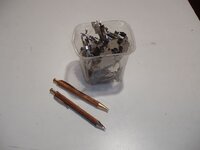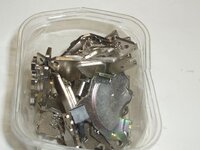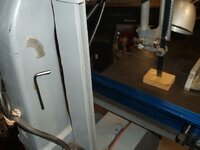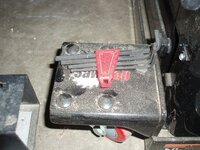TESTING FAILED DRIVE WITH USB to SATA ADAPTER (for 3.5 inch drives)
If all
@jttheclockman wants to do is test the drive on another computer, then he can buy a basic USB to SATA adapter for 3.5 inch drives. The SATA adapter for a 3.5 inch drives should include a power supply or power brick to provide power to the drive.
https://www.amazon.com/s?k=usb+sata+3.5+adapter
Sorry, but the cheaper USB to SATA adapters for 2.5 inch drives do not provide enough power through the USB cable to spin up your larger 3.5 inch drive. Expect to pay between $15 and $20. If it sells for around $10 or less, even if it claims to support 3.5 inch drives, it probably does not include the power brick.
DRIVE DISPOSAL and DATA DESTRUCTION
The fastest and easiest way to destroy a hard drive is to drill a bunch of holes through it using a drill press and an old drill bit. (A drill driver should work if you're careful to clamp the drive and follow good safety practices.)
In the past I have had "emergencies" where there were so many drives to destroy that disassembly was impractical. I used the drill press method.
Be sure to punch several holes all the way through the entire drive, to make sure you drill through all of the platters inside. The platters are at one end of the drive or the other, and their diameter is nearly the same as the drive's width, so they are hard to miss with the drill. Usually the drives case has a round outline that you can feel. If you aren't sure, drill a few more holes all over. Some drives have metal coated glass platters inside, so be ready to contain a mess of shattered glass that may fall out through the bottom of the holes you drill through the drive.
Fun Alternative, Maybe? - Friends have told me about taking their hard drives out to the desert and plinking holes in them with guns, following appropriate safety precautions, of course. I do not know the effectiveness of this approach, but it has to be more fun than drilling a bunch of drives in the shop. If I were to try that, I would make sure that the bullets effectively destroy the platters inside the drive.
Better Solution, with a Bonus Reward
Like Louie (
@monophoto) above, I disassemble hard drives. It helps to have a set of small Torx screwdrivers and also a set of small phillips screwdrivers. There are hidden screws under the stickers, the case top will lift easily once you have found them all. I disassemble to the point where I can remove the platters, separate the individual platters, and bend, twist, and scratch them multiple times between two pliers in my hands. Put each platter in a plastic bag first - some drives have glass platters (with a metal coating). If a glass platter is not in a plastic bag, it will shatter into a bazillion microscopic sharp shards. Imagine a room where the air is filled with a sudden burst of razor sharp glitter. Avoid that.
-> Once the platters from your hard drive are separated and damaged (bent, shattered, drilled, or cut), your data is unrecoverable.
Why do I go to the trouble of disassembling hard drives, you may ask? Good question. Those old spinning hard drives contain two
very powerful neodymium "super" magnets. That's the prize. Those horseshoe shaped magnets are so strong. They are useful for projects, for sticking tools to other tools, etc. etc. etc.
Hint: To remove the horseshoe shaped magnets from their brackets, put on safety glasses, take two pliers and bend the ends of the frame holding the magnet. The magnets are brittle, and trying to pry them off is less effective. A small amount of prying may be necessary after the frame has been bent, but the magnet should remove easily.
Photos:
* Jar of Neodymium Magnets Harvested from Hard Drives. Pen/pencil set shown for scale.
* Closeup - Notice the horseshoe shaped magnet on the frame on top.
* Example Use of Magnets - Bandsaw magnet tool holders. There is a tiny broken magnet piece holding the allen wrench.
* Example Use of Magnets - Table Saw. Those allen wrenches won't come off, even when rolling over bumpy, uneven paving stones.
Sorry, but I don't have photos of those magnets in use on woodworking projects.









